Analysis of the Cutting Performance of Coated Micro-Textured Bionic Tools for Dry Cutting AISI 52100
Abstract
:1. Introduction
2. Finite Element Simulation Analysis
2.1. Finite Element Simulation and Bionic Tool
2.2. The Result of Finite Element Analysis
Cutting Force Simulation Analysis of Cutting Process
2.3. Influence of Concave Camber Angle on Cutting Force
3. Effect of Micro-Textured on Cutting Performance of Bionic Tool with Concave Curved Surface
3.1. Micro-Textured Morphology and Shape Parameters
3.2. Effect of Micro-Textured Type on Cutting Force
3.3. Effect of Micro-Textured Spacing on Cutting Force
4. Bionic Cutting Experiment of Coating 45° Chute Micro-Textured Concave Cambered Surface
4.1. Influence of Cutting Temperature in Coated Concave-Arc Surfaces with 45° Chute Micro-Textured Bionic Tool
4.2. Effect of Cutting Speed on Cutting Force of Coating Tool
5. Conclusions
- (1)
- When using concave arc face bionic tool cutting, experiments can inhibit the generation of cutting force, through the mathematical model and the experimental results of the analysis, concave arc face tool compared to the normal tool to increase the rake angle of the tool; in the back angle of the same conditions of the chip outflow resistance and friction coefficient were reduced; to promote the cutting chip curl fracture, leading to a reduction in cutting force, machining stability was improved. By changing the inclination angle of concave arc surface, it was found that the cutting performance of the bionic tool was optimal when the inclination angle of the arc surface was 15°, and the cutting force decreased by 29%.
- (2)
- The cutting performance of the tool was significantly enhanced when a 45° slant groove micro-textured with a micro-textured pitch of 0.08 was constructed on the rake face of the bionic tool. The combination of slant groove micro-textured and concave curved surface reduced the tool–chip adhesion area, and the chips were captured by the micro-textured site to reduce the phenomenon of secondary cutting. Moreover, the concave-curved surface of the bionic tool body caused the depth of the micro-textured to decrease with the curved surface, which protected the overall stiffness of the tool.
- (3)
- The composite coating material that prompted the cutting temperature reduction ability was more superior, and significantly improved the anti-adhesive and lubrication ability of the tool surface, so that the tool impact resistance was enhanced, and machining stability was improved. Therefore, the coated micro-textured tools should be an important direction for improving cutting performance and optimizing machining efficiency.
Author Contributions
Funding
Data Availability Statement
Acknowledgments
Conflicts of Interest
References
- Zhuang, K.; Fu, C.; Weng, J.; Hu, C. Cutting edge microgeometries in metal cutting: A review. Int. J. Adv. Manuf. Technol. 2021, 116, 2045–2092. [Google Scholar] [CrossRef]
- Zou, X.; D, J.; C, X. Process and method analysis of metal cutting precision. Sci. Wealth 2019, 36, 396. [Google Scholar]
- Cai, W.; Lai, K.H. Sustainability assessment of mechanical manufacturing systems in the industrial sector. Renew. Sustain. Energy Rev. 2021, 135, 110169. [Google Scholar] [CrossRef]
- Chowdhury, M.S.I.; Bose, B.; Yamamoto, K.; Shuster, L.S.; Paiva, J.; Fox-Rabinovich, G.S.; Veldhuis, S.C. Wear performance investigation of PVD coated and uncoated carbide tools during high-speed machining of TiAl6V4 aerospace alloy. Wear 2020, 446, 203168. [Google Scholar] [CrossRef]
- Günay, M.; Korkmaz, M.E.; Yaşar, N. Performance analysis of coated carbide tool in turning of Nimonic 80A superalloy under different cutting environments. J. Manuf. Process. 2020, 56, 678–687. [Google Scholar] [CrossRef]
- Gouarir, A.; Martínez-Arellano, G.; Terrazas, G.; Benardos, P.; Ratchev, S.J.P.C. In-process tool wear prediction system based on machine learning techniques and force analysis. Procedia CIRP 2018, 77, 501–504. [Google Scholar] [CrossRef]
- He, Z.; Shi, T.; Xuan, J.; Li, T. Research on tool wear prediction based on temperature signals and deep learning. Wear 2021, 478, 203902. [Google Scholar] [CrossRef]
- L, W. Talk about dry cutting technology. Sci. Informatiz. 2019, 2, 65. [Google Scholar]
- Wu, Z.; Yang, Y.; Su, C.; Cai, X.; Luo, C. Development and prospect of cooling technology for dry cutting tools. Int. J. Adv. Manuf. Technol. 2017, 88, 1567–1577. [Google Scholar] [CrossRef]
- Jianxin, D.; Ze, W.; Yunsong, L.; Ting, Q.; Jie, C. Performance of carbide tools with textured rake-face filled with solid lubricants in dry cutting processes. Int. J. Refract. Met. Hard Mater. 2012, 30, 164–172. [Google Scholar] [CrossRef]
- Bayraktar, S. Dry cutting: A sustainable machining technology. In Sustainable Manufacturing; Elsevier: Amsterdam, The Netherlands, 2021; pp. 231–257. [Google Scholar]
- Su, Y.; Li, Z.; Li, L.; Wang, J.; Gao, H.; Wang, G. Cutting performance of micro-textured polycrystalline diamond tool in dry cutting. J. Manuf. Process. 2017, 27, 1–7. [Google Scholar] [CrossRef]
- Niketh, S.; Samuel, G.L. Drilling performance of micro textured tools under dry, wet and MQL condition. J. Manuf. Process. 2018, 32, 254–268. [Google Scholar]
- Devaraj, S.; Malkapuram, R.; Singaravel, B. Performance analysis of micro textured cutting insert design parameters on machining of Al-MMC in turning process. Int. J. Lightweight Mater. Manuf. 2021, 4, 210–217. [Google Scholar] [CrossRef]
- Arulkirubakaran, D.; Senthilkumar, V.; Kumawat, V. Effect of micro-textured tools on machining of Ti–6Al–4V alloy: An experimental and numerical approach. Int. J. Refract. Met. Hard Mater. 2016, 54, 165–177. [Google Scholar] [CrossRef]
- Patel, K.; Liu, G.; Shah, S.R.; Özel, T. Effect of micro-textured tool parameters on forces, stresses, wear rate, and variable friction in titanium alloy machining. J. Manuf. Sci. Eng. 2020, 142, 021007. [Google Scholar] [CrossRef]
- Chen, Y.; Guo, X.; Zhang, K.; Guo, D.; Zhou, C.; Gai, L. Study on the surface quality of CFRP machined by micro-textured milling tools. J. Manuf. Process. 2019, 37, 114–123. [Google Scholar] [CrossRef]
- Li, Q.; Pan, C.; Jiao, Y.; Hu, K. Investigation on cutting performance of micro-textured cutting tools. Micromachines 2019, 10, 352. [Google Scholar] [CrossRef]
- Ma, J.; Zhang, M.; Liu, Q.; Liu, X.; Yue, C.; Yang, S. Review of bionic tool research progress. J. Mech. Eng. 2022, 58, 261–281. [Google Scholar] [CrossRef]
- Zhang, W.; Zhang, L.; Wang, B.; Wang, S. Finite element simulation analysis of bionic ball-end milling cutter. Int. J. Adv. Manuf. Technol. 2019, 103, 3151–3161. [Google Scholar] [CrossRef]
- Lian, Y.; Xie, C.; Zhou, W.; Chu, X.; Zhao, G. Study on the performance of bionic cutting tool for dry cutting GH4169 based on the surface microstructure of hemarca granosa. J. Mech. Eng. 2021, 57, 242–251. [Google Scholar] [CrossRef]
- Duan, R.; Deng, J.; Lei, S.; Ge, D.; Liu, Y.; Li, X. Effect of derivative cutting on machining performance of micro textured tools. J. Manuf. Process. 2019, 45, 544–556. [Google Scholar] [CrossRef]
- Szczotkarz, N.; Mrugalski, R.; Maruda, R.W.; Królczyk, G.M.; Legutko, S.; Leksycki, K.; Dębowski, D.; Pruncu, C.I. Cutting tool wear in turning 316L stainless steel in the conditions of minimized lubrication. Tribol. Int. 2021, 156, 106813. [Google Scholar] [CrossRef]
- Behera, B.C.; Setti, D.; Ghosh, S.; Rao, P.V. Spreadability studies of metal working fluids on tool surface and its impact on minimum amount cooling and lubrication turning. J. Mater. Process. Technol. 2017, 244, 1–16. [Google Scholar] [CrossRef]
- Sousa, V.F.; Silva, F.J. Recent advances in turning processes using coated tools—A comprehensive review. Metals 2020, 10, 170. [Google Scholar] [CrossRef]
- Mohanty, A.; Gangopadhyay, S.; Thakur, A. On applicability of multilayer coated tool in dry machining of aerospace grade stainless steel. Mater. Manuf. Process. 2016, 31, 869–879. [Google Scholar] [CrossRef]
- Zheng, G.; Zhao, G.; Cheng, X.; Xu, R.; Zhao, J.; Zhang, H. Frictional and wear performance of TiAlN/TiN coated tool against high-strength steel. Ceram. Int. 2018, 44, 6878–6885. [Google Scholar] [CrossRef]
- Panda, A.; Sahoo, A.K.; Kumar, R.; Das, R.K. A review on machinability aspects for AISI 52100 bearing steel. Mater. Today Proc. 2020, 23, 617–621. [Google Scholar] [CrossRef]
- Sharma, N.; Gupta, K. Influence of coated and uncoated carbide tools on tool wear and surface quality during dry machining of stainless steel 304. Mater. Res. Express 2019, 6, 086585. [Google Scholar] [CrossRef]
- Fan, L.; Deng, Z.L.; He, Y.; Zhu, X.L.; Gao, X.J.; Jin, Z. The effects of micro-texture shape on serrated chip geometry in the hardened steel AISI D2 cutting process. Surf. Topogr. Metrol. Prop. 2022, 10, 015031. [Google Scholar] [CrossRef]
- Weilin, C.; Dong, Y.; Min, W.; Ma, H. Simulation study on right-angle cutting of 7050-T7451 aluminum alloy. Mech. Manuf. 2021, 59, 63–67. [Google Scholar] [CrossRef]
- Hongbo, P.; Hongjian, Z. Research progress on the intrinsic structure model of metallic materials. Mech. Eng. Mater. 2012, 36, 5–10+75. [Google Scholar]
- Zheng, K.; Yang, F.; Pan, M.; Zhao, G.; Bian, D. Effect of surface line/regular hexagonal texture on tribological performance of cemented carbide tool for machining Ti-6Al-4V alloys. Int. J. Adv. Manuf. Technol. 2021, 116, 3149–3162. [Google Scholar] [CrossRef]
- Liu, P.D.; Duan, J.Y. (Eds.) Metal Cutting Principles and Tools (TG501;TG71); Jilin University Press: Jilin, China, 2016. [Google Scholar]
- Xin, T.; Pei, H.; Shucai, Y. Coating and micro-texture techniques for cutting tools. J. Mater. Sci. 2022, 57, 17052–17104. [Google Scholar] [CrossRef]
- Xiang, D.; Feng, H.; Guo, Z.; Zhang, L.; Wu, B. Preparation technology and properties of microtexture diamond-coated tools. Int. J. Refract. Met. Hard Mater. 2018, 76, 16–24. [Google Scholar] [CrossRef]
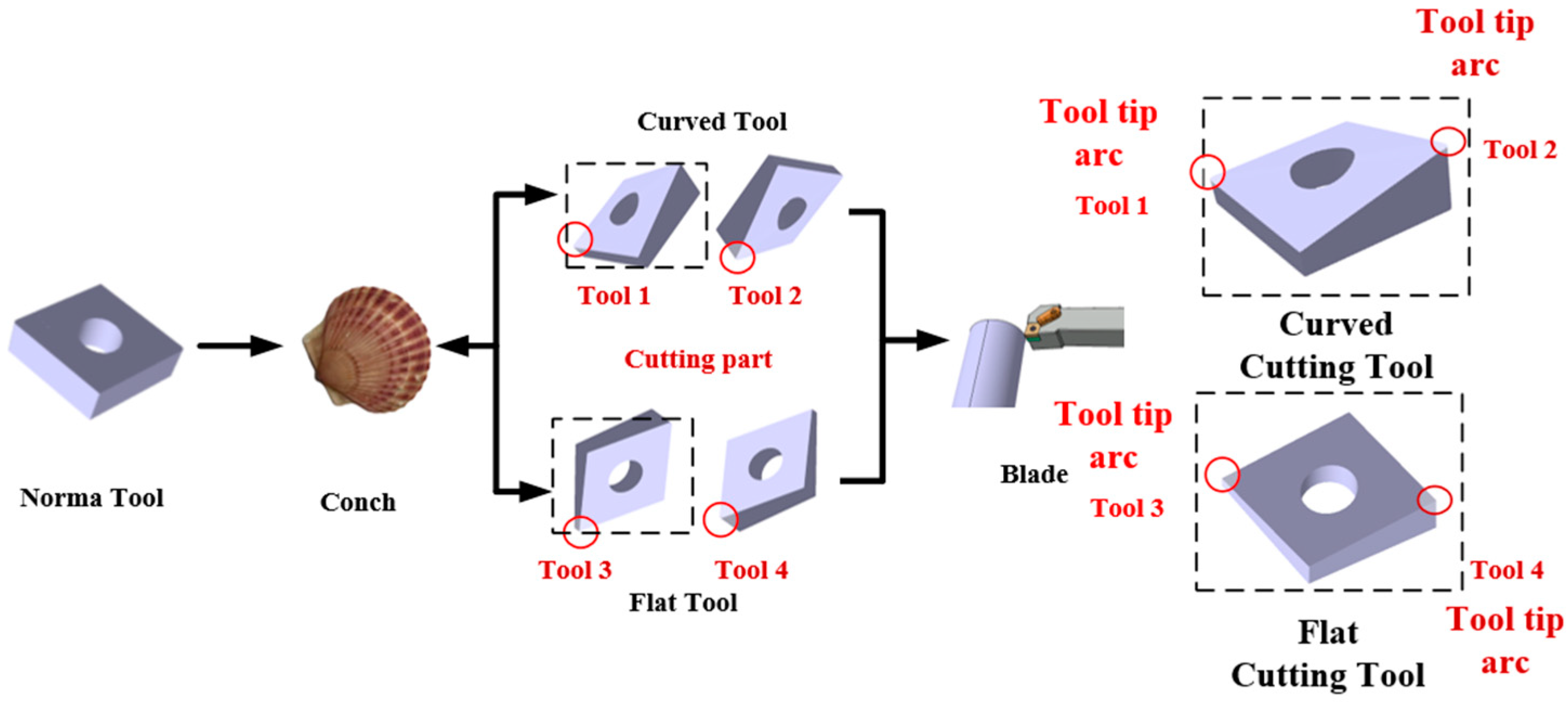

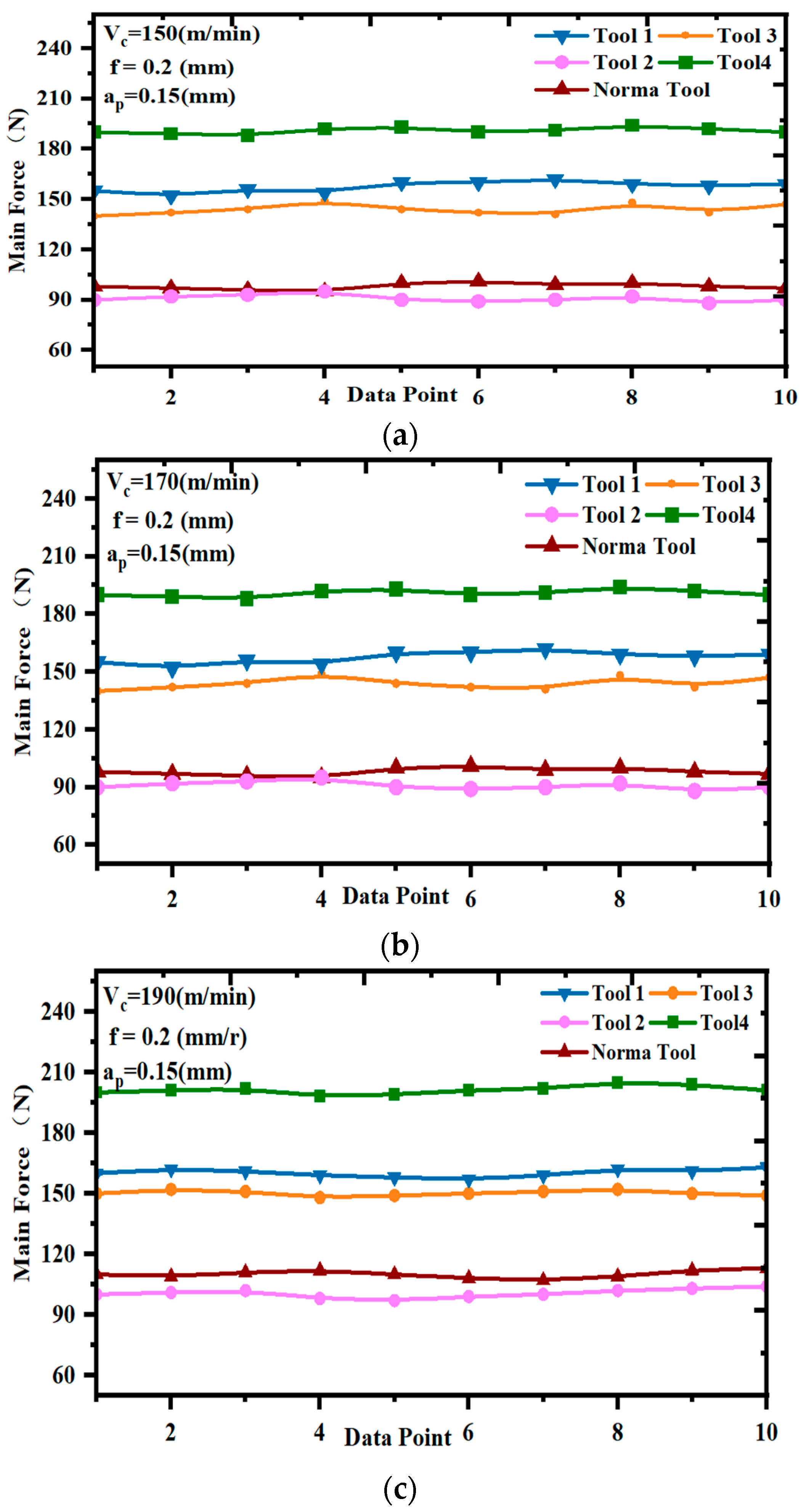

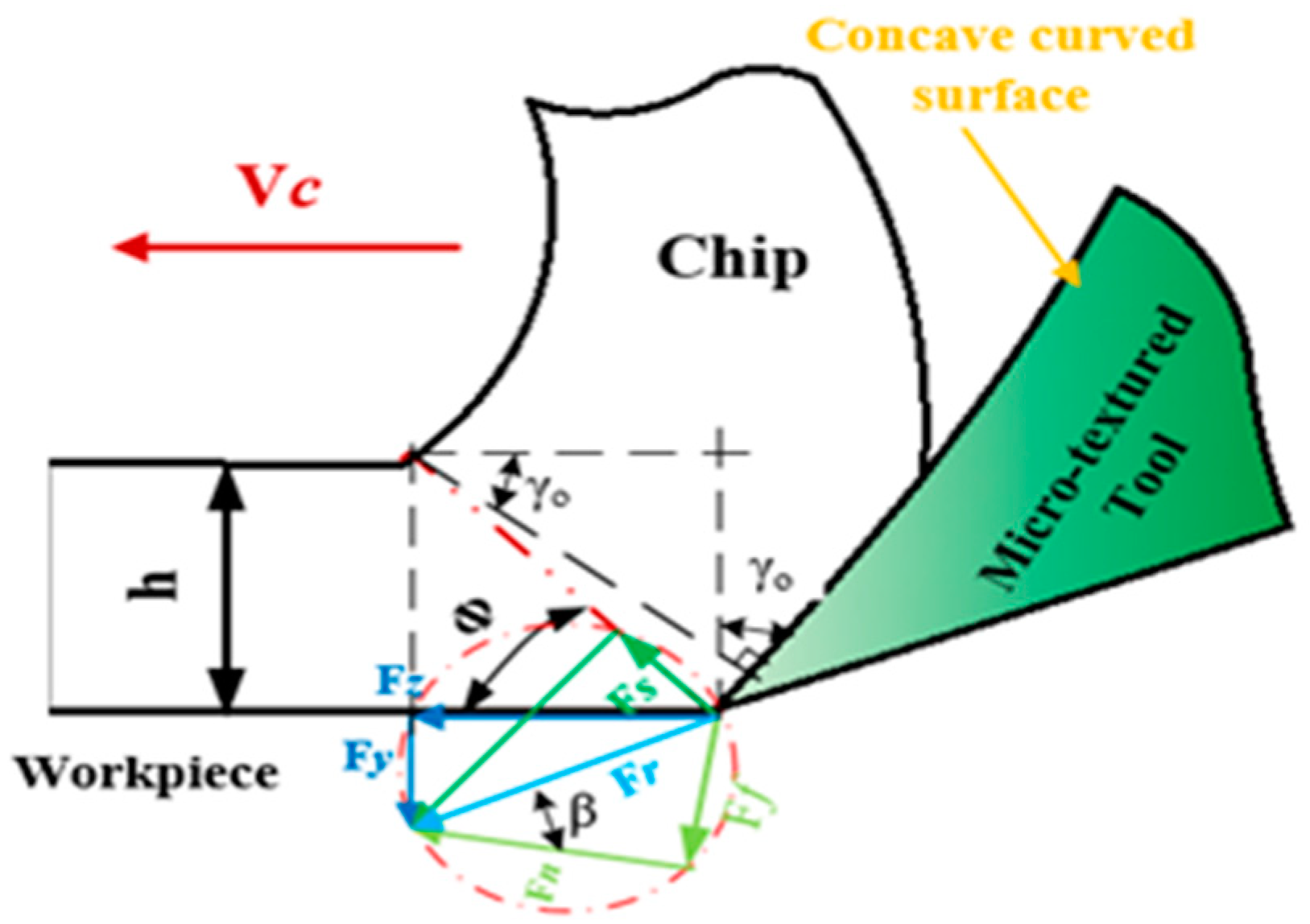



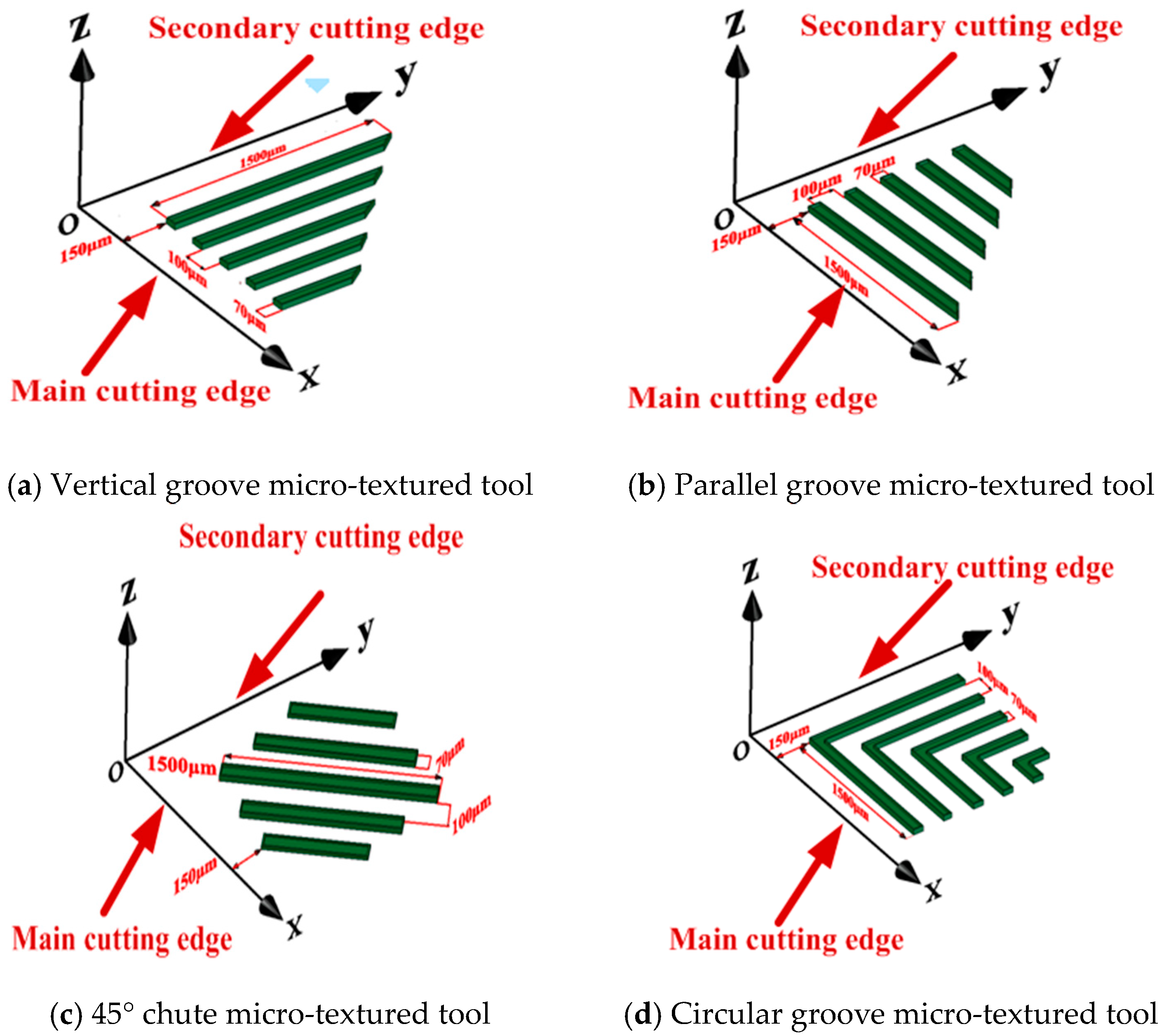



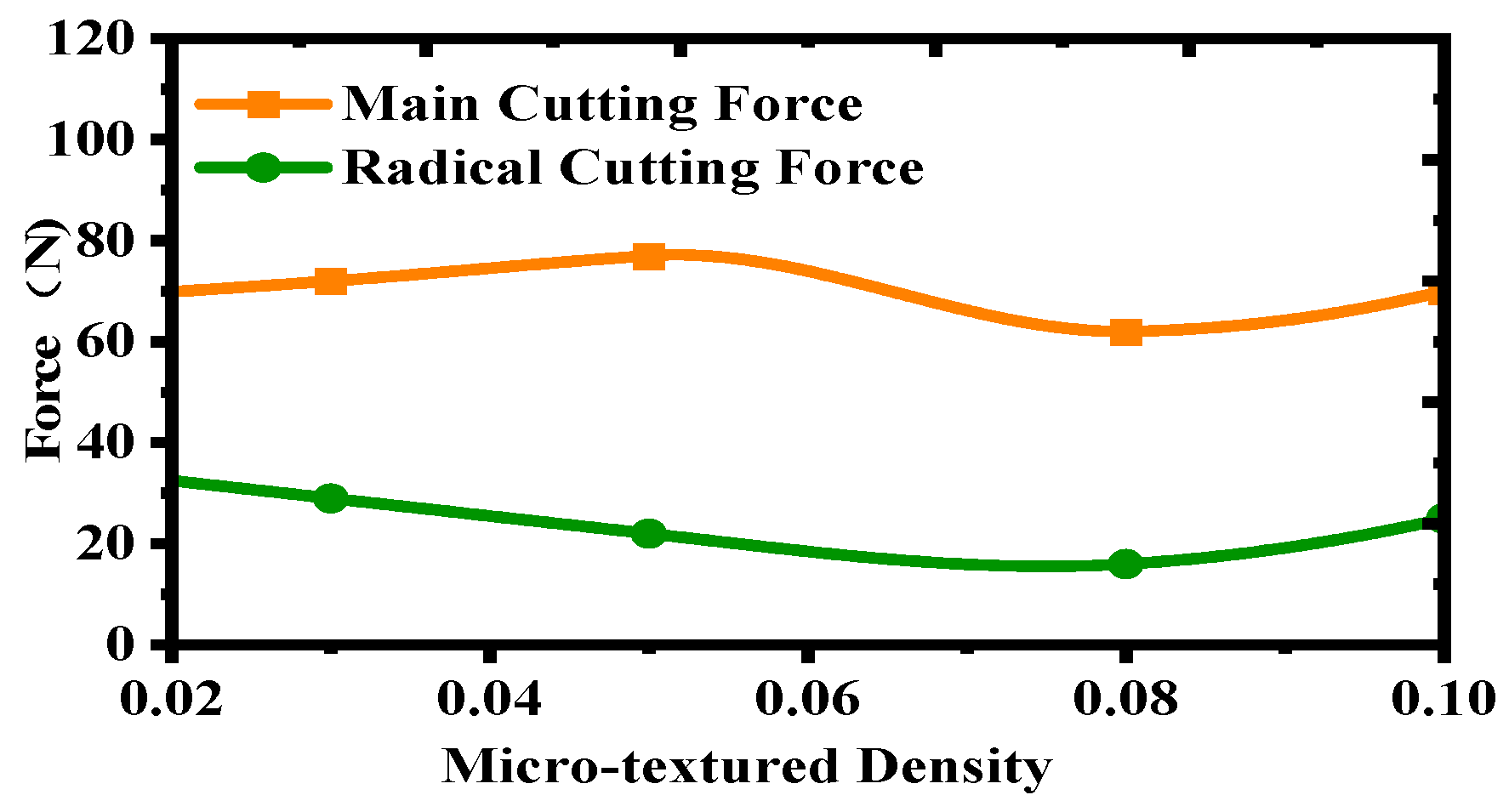



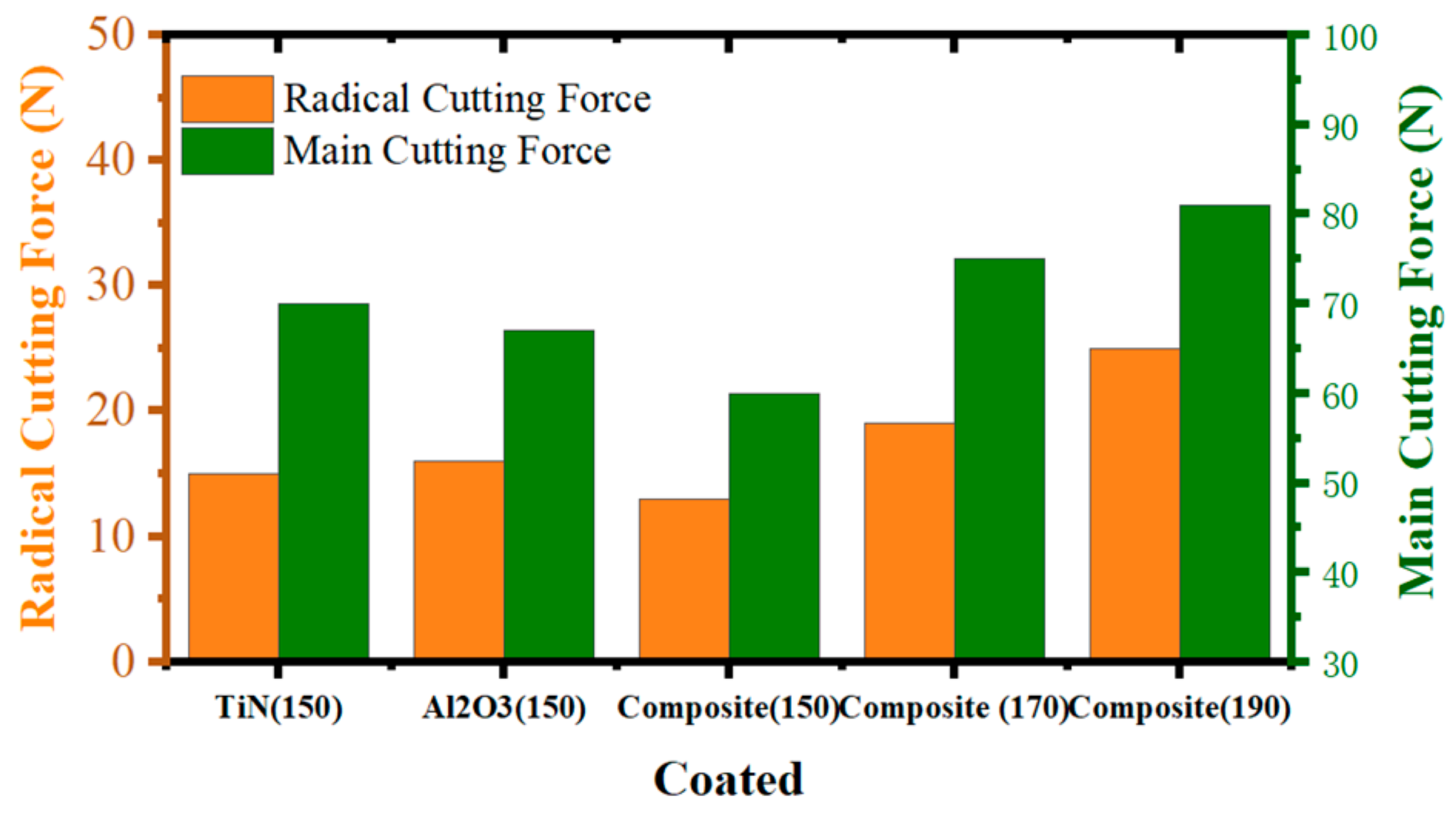
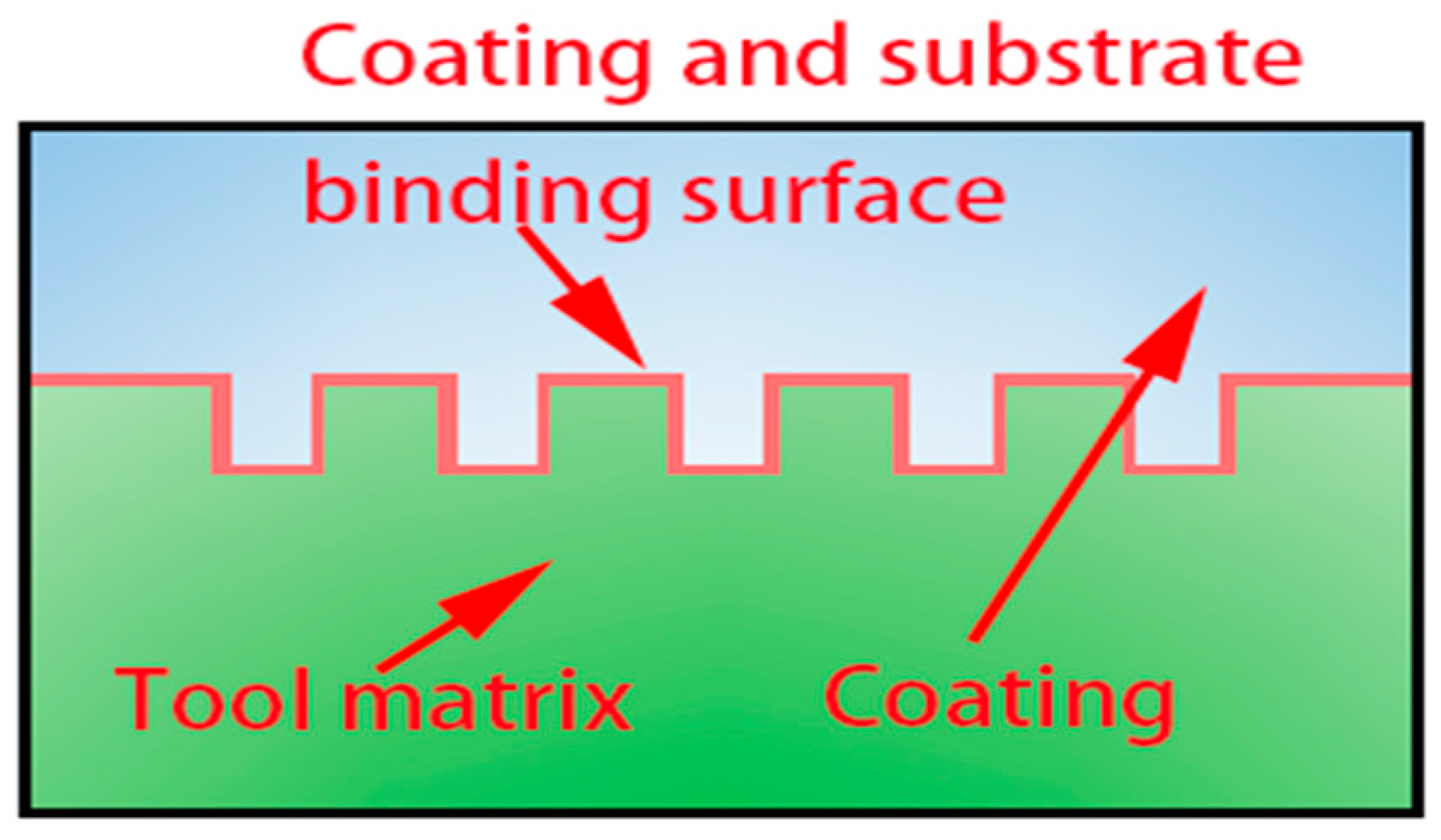
| A (GPa) | B (GPa) | C | n | m | t0 (°C) | tm (°C) |
|---|---|---|---|---|---|---|
| 1.204 | 1.208 | 0.036 | 0.12 | 0.89 | 20 | 1180 |
| Material Properties | Young’s Modulus (GPa) | Thermal Conductivity (W/m·K) | Poisson Ratio | Density (g/cm3) | Specific Heat (J/kg·K) |
|---|---|---|---|---|---|
| Value | 210 | 43 | 0.3 | 7.85 | 458 |
| Group | Cutting Speed vc (m/min) | Feed f (mm/r) | Depth of Cut ap (mm) |
|---|---|---|---|
| 1 | 150 | 0.2 | 0.15 |
| 2 | 170 | 0.2 | 0.15 |
| 3 | 190 | 0.2 | 0.15 |
| 45° chut groove micro-textured space | 0.02 mm | 0.04 mm | 0.06 mm | 0.08 mm | 0.10 mm |
Disclaimer/Publisher’s Note: The statements, opinions and data contained in all publications are solely those of the individual author(s) and contributor(s) and not of MDPI and/or the editor(s). MDPI and/or the editor(s) disclaim responsibility for any injury to people or property resulting from any ideas, methods, instructions or products referred to in the content. |
© 2023 by the authors. Licensee MDPI, Basel, Switzerland. This article is an open access article distributed under the terms and conditions of the Creative Commons Attribution (CC BY) license (https://creativecommons.org/licenses/by/4.0/).
Share and Cite
Li, Q.; Ma, C.; Wang, C.; Wang, B.; Zhang, S. Analysis of the Cutting Performance of Coated Micro-Textured Bionic Tools for Dry Cutting AISI 52100. Machines 2023, 11, 886. https://doi.org/10.3390/machines11090886
Li Q, Ma C, Wang C, Wang B, Zhang S. Analysis of the Cutting Performance of Coated Micro-Textured Bionic Tools for Dry Cutting AISI 52100. Machines. 2023; 11(9):886. https://doi.org/10.3390/machines11090886
Chicago/Turabian StyleLi, Qinghua, Chunlu Ma, Chunyu Wang, Baizhong Wang, and Shihong Zhang. 2023. "Analysis of the Cutting Performance of Coated Micro-Textured Bionic Tools for Dry Cutting AISI 52100" Machines 11, no. 9: 886. https://doi.org/10.3390/machines11090886





